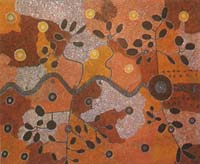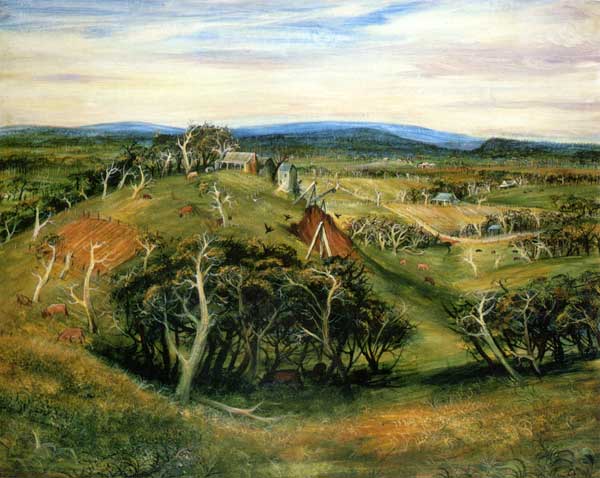The concept of property was clearly known to Aboriginal Australians, but defined by sacred sites, by walking tracks, waterholes and bush tucker, and by traditional 'extended family' occupation, rather than by fenced boundaries. Invading Europeans found it difficult to comprehend this concept of property, and, in any case, found it in their interest to disregard it. Aboriginals often speak of their responsibility for protecting and caretaking the land. This aspect of 'property ownership’, while very familiar in Europe, was not widespread among the pastoralists and agriculturalists who settled in the colonies. The concept of ownership which prevailed was one which emphasised dominion and rights of exploitation according to private economic interest.

4.15
Dinny Nolan, Water dreaming mythology, n.d.
Acrylic on canvas, 102 x 152 cm
Collection of Clifton Pugh
The painting of Mikantji, that's my country, not anybody's at all, that's our country. It's our grandfathers' country, fathers' country and we. All the Tjangala and jampitjimpa are looking after that country.
Dinny Nolan
It requires only a slight effort of the mind to see this landscape through the proud eyes of the farmer and an equally slight effort to see it through bewildered Aboriginal eyes.
The felling or ring-barking of forests, the choking of streams, the destruction of the topsoil – these were mostly the handiwork of agriculturalists; and much of this damage was done after Colonial Australia had gone. Streams, waterholes, lagoons and forests that eighty years of pastoralism had left intact, thirty years of agriculture could and did turn into the sunburnt country.
Denholm, 1979
This painting may give some impression of the landscape which the Aboriginals see when they say 'This country bin losin' song, eh?' (from a lecture by Rhys Jones, 1981). A geometric order of straight lines and right angles is an abstract and highly arbitrary rearrangement of nature, which to Aboriginal eyes, accustomed to another kind of order, must have appeared as much a chaos and wilderness as the primeval forest seemed to early settlers.

4.16
Arthur Boyd, Berwick landscape, 1948
Tempera on board, 69.8 x 87.6 cm
Colleetion of the Queensland Art Gallery
FURTHER READING
Bardon, Geoff, Aboriginal art of the Western Desert, Rigby, Adelaide, 1979
Carmichael, Makin and Wolseley, Orienteering, DUP, Geelong, 1982
Denholm, David, The colonial Australians, Allen Lane, Ringwood, 1979
Flower, Cedric, The Antipodes observed, Macmillan, Melbourne, 1975
McCullough, Bianca, Each man's wilderness, Rigby, Adelaide, 1980
Morphy, Howard, Manggalili art: catalogue, reprint Deakin University, 1983
Powell, J.M., Environmental management in Australia, 1788-1914, Oxford University Press, Melbourne, 1980
Powell, J.M. (ed.), The making of rural Australia, Sorrett Publishing, Melbourne, 1980 Tuan, Yi-Fu, Topophilia, Prentice-Hall, Englewood Cliffs, 1974